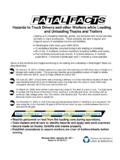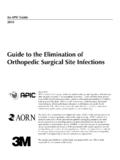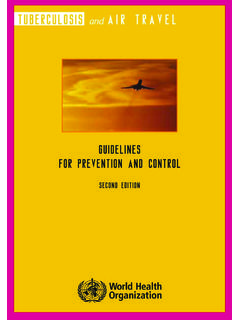Transcription of 1N3X1X CFETP FINAL 28 Apr 14 - AF
1 UNCLASSIFIED. DEPARTMENT OF THE AIR FORCE CFETP 1N3X1X . Headquarters US Air Force Parts I and II. Washington, DC 20330-1030 1 MAY 2014. AFSC 1N3X1X . CRYPTOLOGIC LANGUAGE ANALYST. CAREER FIELD EDUCATION. AND. TRAINING PLAN. ACCESSIBILITY: Publications and forms are available on the e-publishing website at for downloading or ordering. RELEASABILITY: There are no releasability restrictions on this publication. UNCLASSIFIED. UNCLASSIFIED. CAREER FIELD EDUCATION AND TRAINING PLAN ( CFETP ). CRYPTOLOGIC LANGUAGE ANALYST. AFSC 1N3X1X . Table of Contents PART 1 PREFACE .. 1 ABBREVIATIONS/TERMS EXPLAINED .. 2 SECTION A, GENERAL INFORMATION .. 9 Purpose of the 9 Use of the CFETP .. 9 Coordination and Approval of the CFETP .. 10 SECTION B, CAREER PROGRESSION AND INFORMATION .. 10 Specialty Description .. 10 Skill/Career 10 Training Decisions.
2 11 Community College of the Air Force (CCAF) .. 14 Career Field Path .. 17 SECTION C - SKILL LEVEL TRAINING REQUIREMENTS .. 19 19 Specialty Qualification Requirements .. 19 SECTION D RESOURCE CONSTRAINTS .. 24 SECTION E TRANSITIONAL TRAINING GUIDE .. 24 PART II .. 25 SECTION A SPECIALTY TRAINING STANDARD .. 25 SECTION B - COURSE OBJECTIVE LIST .. 40 SECTION C SUPPORT MATERIAL .. 40 SECTION D TRAINING COURSE INDEX .. 40 SECTION E MAJCOM UNIQUE REQUIREMENTS .. 42 ATTACHMENTS .. 27 ATTACHMENT 1 QUALITATIVE REQUIREMENTS .. 27 ATTACHMENT 2 1NX COMMON CORE SPECIALTY TRAINING STANDARD .. 29 ATTACHMENT 3 1N3X1X CRYPTOLOGIC LANGUAGE ANALYST SPECIALTY TRAINING STANDARD .. 34. OPR: 316th TRS/XPP (Mr. Dan Young, AETC Training Manager). Certified By: AF/A2 DFM (SMSgt Deborah Shamlin). Approved By: HQ USAF/A2 (Lt Gen Robert S.)
3 Otto). Supersedes: CFETP 1N3X1, 4 March 2011. Pages: 42. UNCLASSIFIED. UNCLASSIFIED. CRYPTOLOGIC LANGUAGE ANALYST. AFSC 1N3X1X . CAREER FIELD EDUCATION AND TRAINING PLAN. Part I. Preface 1. This Career Field Education and Training Plan ( CFETP ) is a comprehensive education and training document that identifies life-cycle education/training requirements, and training support resources. The CFETP will provide personnel a clear career path to success and will instill rigor in all aspects of career field training. Civilians occupying associated duty positions will use Part II to support duty position qualification training. 2. The CFETP consists of two parts; supervisors use both parts of the plan to plan, manage, and control training within the career field. Part I provides information necessary for overall management of the specialty.
4 Section A. explains how everyone will use the plan. Section B identifies career field progression information, duties and responsibilities, training strategies, and career field path. Section C. associates each level with specialty qualifications (knowledge, experience, training, and other). Section D indicates resource constraints: Some examples are funds, manpower, equipment, and facilities. Section E, when used, identifies transition training guide requirements. Part II includes the following: Section A identifies the Specialty Training Standard (STS). and includes duties, tasks, and technical references to support training, Air Education and Training Command (AETC) conducted training, wartime course, and correspondence course requirements; Section B contains the course objective list and training standards supervisors will use to determine if airmen satisfied training requirements; Section C identifies available support materials; Section D identifies a training course index supervisors can use to determine resources available to support training, including both mandatory and optional courses; Section E.
5 Identifies MAJCOM unique training requirements supervisors can use to determine additional training required for the associated qualification needs. At the unit level, supervisors, trainers, Command Language Program Managers (CLPMs), Language Mentors, and Subject Matter Experts (SMEs) will use Part II to identify, plan, and conduct training commensurate with the overall goals of this plan. 3. Using guidance provided in the CFETP will ensure individuals in this specialty receive effective and efficient training at the appropriate point in their career. This plan will enable us to train today's work force for tomorrow's jobs. 1. UNCLASSIFIED. UNCLASSIFIED. ABBREVIATIONS/TERMS EXPLAINED. Advanced Degree Programs. Programs at locations such as the National Intelligence University (NIU) and the Air Force Institute of Technology (AFIT) that prepare Intelligence, Surveillance and Reconnaissance professionals through education and research, to work with skill and dedication in identifying and effectively integrating foreign, military, and domestic intelligence in defense of the homeland and of interests abroad.
6 Air Force Enlisted Classification Directory (AFECD). The directory containing the official specialty descriptions for all enlisted military classification codes and identifiers used to identify an Air Force job. The AFECD outlines the minimum mandatory qualifications necessary to fill a particular job. These standards are used to procure, classify and employ personnel. Air Force Service Cryptologic Component (AF SCC). Principal advisor to Headquarters Air Force, A2 Directorate for all programming, budgeting, training, personnel, policy, doctrine, governance and foreign relationships for USAF cryptologic activities. Service lead for AF. cryptologic activities and has management oversight of those elements of the USAF performing cryptologic functions. This applies to the cryptologic staff of the AF ISR Agency, its subordinate elements, and cryptologic elements assigned to other USAF organizations.
7 The AF. ISR Agency Commander is the AF/SCC Commander and principal USAF advisor to DIRNSA/CHCSS for USAF cryptologic matters (Ref: AFI 14-128). Air Force Career Field Manager (AFCFM). Representative appointed by the respective HQ. USAF Deputy Chief of Staff or Under Secretariat, to ensure assigned AF specialties are trained and utilized to support AF mission requirements. Their responsibilities include establishing career field entry requirements, managing trained personnel requirements, and developing and managing career-long training plan requirements and programs. They also construct viable career paths, evaluate training effectiveness, monitor health and manning of the career field, and provide input on manning personnel policies and programs. Additionally, they implement and advise on changes to force management policies and programs, develop contingency planning actions, validate deployment requirements, and verify workforce availability.
8 Enlisted AFCFMs are typically CMSgts and are normally located at Headquarters, Air Force. There is a separate AFCFM for Active Duty, Air National Guard, and the Air Force Reserve components for a career field (Ref: AFI 36-2618). Air Force Institute of Technology (AFIT). See Part II, Section Air Force Specialty (AFS) Manager. AFS expert on the HQ USAF staff responsible for overseeing all aspects of a particular Air Force Specialty. Coordinates with MAJCOM and FOA. functional and training managers, technical training center personnel, Career Development Course writers and subject matter experts to provide career path development and identify Career Field Education and Training Plan training tasks items to meet national, tactical and Air Force training requirements. Other responsibilities include reviewing AFS manpower utilization, managing AFS classification guidance, and overall status of the health of their particular AFS.
9 2. UNCLASSIFIED. UNCLASSIFIED. Air Force Job Qualification Standard/Command Job Qualification Standard (AFJQS/CJQS). A comprehensive task list that describes a particular job type or duty position. It is used by supervisors to document task qualifications. The tasks on AFJQS/CJQS are common to all persons serving in the described duty position. Air Force Specialty Code (AFSC)/Reporting Identifier (RI). A combination of alpha-numeric characters which are used to identify a specific career field and qualification level for Air Force officers and enlisted personnel. Bachelor of Science in Intelligence (BSI). See Part II, Section Career Development Course (CDC). Self-paced, correspondence course published to provide the information necessary to satisfy the career knowledge component of on-the-job training (OJT).
10 These courses are developed from references identified in the CFETP correlating with mandatory knowledge items listed in the Air Force Enlisted Classification Guide. CDCs will contain information on basic principles, techniques, and procedures common to an AFSC. They do not contain information on specific equipment or tasks unless best illustrating a procedure or technique having utility to the entire AFSC (Ref: AFI 36-2201). Career Field Education and Training Plan ( CFETP ). A CFETP is a comprehensive core training document that identifies life-cycle education and training requirements, training support resources, and minimum core task requirements for a specialty. The CFETP aims to give personnel a clear path and instill a sense of industry in career field training (Ref: AFI 36-2201). Certificate of Intelligence Studies (CIS).













